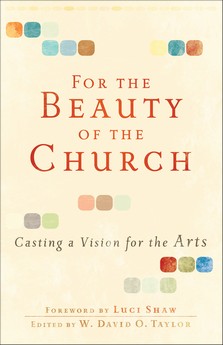 For the Beauty of the Church is book for both pastors and artists, and that’s not a marketing ploy. Both artists and pastors are present, not only as the book’s audience but also among its contributors. The book bears a sincere burden, pastoral and artistic, carried gracefully by a group of theologians, pastors, patrons, and artists, led by an articulate, winsome, and wise artist-theologian-pastor, David O. Taylor.
For the Beauty of the Church is book for both pastors and artists, and that’s not a marketing ploy. Both artists and pastors are present, not only as the book’s audience but also among its contributors. The book bears a sincere burden, pastoral and artistic, carried gracefully by a group of theologians, pastors, patrons, and artists, led by an articulate, winsome, and wise artist-theologian-pastor, David O. Taylor.
Theological and Practical
For the Beauty of the Church sets itself apart from many books on church and art because it offers time-tested wisdom and theologically anchored vision. As Taylor points out, we can cheapen art by reducing it to a church tool for Sundays (pragmatism) or we can cheapen church with an inadequate theology of the arts. For the Beauty of the Church steers right between both dangers, offering helpful practice and theological depth.
In the words of the introduction: The book begins at the beginning: “The Gospel.†It ends with a vision of the church’s future in the year 2058: “The Future.†In between, the book addresses key components for an integrated vision: “The Worshiper,†“The Art Patron,†“The Pastor,†“The Artist,†“The Practitioner,†and “The Dangers.â€
A Sprint Through the Book
Although the book is worthy of a more extensive review, I will offer a sprint through its content. In chapter one, the delightful prose and cultural strength of Andy Crouch lays the theological foundation. Though other contributors could have done a better job at laying a biblical-theological foundation, Andy certainly delivers thoughtful biblical reflections that get the reader’s mind going in the right direction.
It’s hard to find a more qualified person to write chapter two on worship and the Arts. John Witvliet is the Director of the Calvin Institute for Christian Worship. His reflections are at once theological and practical, guiding the church away from sentimentality and idolatry in the Arts to worship that is corporate, communal, and iconic.
We get to read Laura Winner’s words in chapter three, where she offers “a patron/pew” perspective with a Jewish twist. Eugene Peterson gives sage witness to the role of artists in the church, while chapters five and six tackle the artist’s identity and practice. Finally, the dangers of artistic activity in the church are elaborated and expanded upon in chapter seven, not something you would expect in a book promoting a vision for the art in the church!
For the Beauty of the Church is a beautiful book, in more ways than one. David wants to show us how to hold art and church together without cheapening either, and he and his contributors have done just that.
